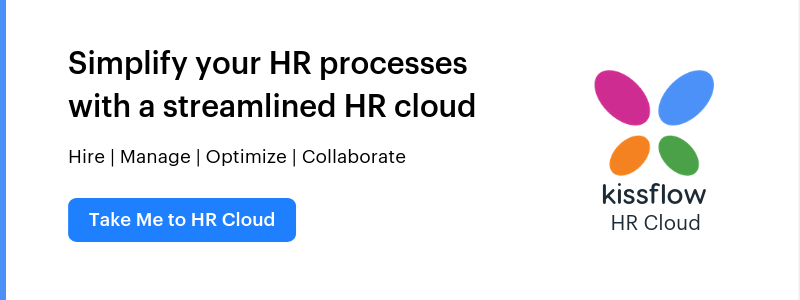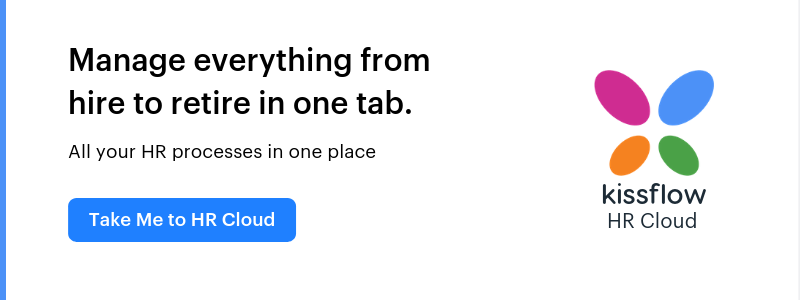
- >
- Human Resources >
- Top 7 Reasons Why Companies Invest in a Attendance Management System
Top 7 Reasons Why Companies Invest in a Attendance Management System
Team Kissflow
Updated on 21 May 2025 • 6 min read
From traditional punch cards to modern access cards and biometric systems, tracking employee working hours has been an essential process. Employees are expected to keep track of their check-in time once they arrive for work and note down their check-out time when they leave. In reality, most employees fill out their timesheets in a hurry, right before they leave for the day.
In worst-case scenarios, this process happens only on the last day of the week/month, right before they turn in timesheets to HR. Manual timekeeping practices take a toll on employee productivity and morale. Filling out working hours days or weeks after the actual working day will only lead to inaccuracies, timesheet tampering, and so on.
Without a reliable employee attendance management system, organizations risk compliance issues, payroll inaccuracies, and operational inefficiencies. Transitioning from paper-based timesheets to robust attendance management software can save time, reduce administrative workload, ensure accurate attendance records, and eliminate process bottlenecks—particularly when seamlessly integrated with employee expense management systems for a more streamlined and efficient HR workflow.
What is attendance management?
"Attendance management is the process of preventing employee time theft by tracking employee working hours, login time, departures, breaks, and time off. Organizations use a number of methods, from punching cards and spreadsheets to automated attendance management systems and biometric devices—as they do with an employee onboarding application to streamline and digitize the onboarding process
7 signs that your organization needs an attendance management system
Every organization needs to keep track of how their employees spend their time, especially when they work with clients and offer services at an hourly rate. Attendance management is necessary not only to bill clients properly but also to reduce the time HR managers and finance officers spend on administrative and attendance management activities.
To prevent a situation where your online attendance management system collapses, organizations must need to look for some tell-tale signs that indicate your current attendance management system is no longer working.
- There is no transparency in your attendance management process
- Your attendance tracker makes your employees resort to manual tracking
- Employees or anyone else can modify confidential attendance data easily
- Your attendance system lacks some critical functionalities like multi-level approvals, mobile submission, and biometric integration
- You have no way to prevent compliance risks like buddy punching
- There isn’t enough information to make informed business decisions
- Scheduling nightmares and headcount shortages have become a common thing
Popular attendance management systems
Some of these popular attendance management systems include all the features mentioned and more. These HR tools more than just attendance tracking and includes other functionalities like overtime management, leave management, and real-time reports.
1. Kissflow HR Cloud
Kissflow HR Cloud is a cloud-based attendance tracking system that empowers employees to mark their attendance at any time on any device. It helps organizations avoid problems like buddy punching, punch-in failures, and more. Best of all, businesses can integrate it with their biometric system and help businesses streamline all their HR functions from hire to retire.
Ideal for: organizations of all sizes
Price: starts from $690 per month
2. GreytHR
GreytHR solves major HR challenges like attendance, leave, and payroll in a single interface. It captures attendance data in real-time from varied sources and integrates the attendance management system with the inbuilt payroll module.
Ideal for: small to mid-sized organizations
Price: It offers three different plans. However, the attendance module is only available in the high-end module.
3. Zoho People
Zoho People offers an array of HR processes including attendance and time-tracking as a service through their elaborate self-service portal. Similar to other SaaS platforms, it can be plugged with an organization’s current biometric system. Its geofencing feature helps restrict the location of check-in using an IP address.
Ideal for: SMBs and Medium enterprises
Price: Zoho people has 4 plans. However, attendance and shift scheduling are not a part of low-end plans.
4. Kronos Workforce Management
Kronos Workforce Management has a long history and reputation of being a pioneer in the time-tracking segment with its first patented microprocessor-based time clock. It offers nearly five products within the time and attendance tracking umbrella.
Ideal for: mid to large-sized organizations
Price: Kronos Workforce Central is not available on the website, it is only available on a quote basis.
5.SumHR
Employees can track, record, and submit their daily attendance using SumHR’s attendance feature. It is designed to capture attendance time based on the ‘first in’ and ‘last out’ of employees. It not only displays shift timing and duration but also allows employees to check their attendance details upto 90 days.
Ideal for: small organizations and startups
Price: SumHR pricing starts at $0.74 per employee per month
5 Essential features every attendance management system should have
Not all attendance management systems are created equally. Some have better functionalities than others. When looking for a new technological solution, naturally you’d want to choose the best. Although each organization may have unique needs, here are some essential features every business needs and should never, ever compromise on.
1. Web-based attendance management system
With a web-based employee attendance software that tracks, collects, stores, and displays up-to-date, timesheets, HR leaders can get rid of spreadsheets and paper files.
Storing employee timesheets and attendance details in a centralized cloud-based attendance management system will:
- Increase accuracy
- Ensure data integrity
- Improve employee productivity
- Reduce administrative work
- Lower admin costs and
- Enhance the efficiency of HR staff
A web-based attendance management system will eliminate missed punches, incorrect time-entries, maintain an accurate record of attendance data with little to no supervision. HR staff don’t have to sift through piles of timesheets to process payrolls or retrieve employee working hours.
The web-based system displays all related time information in a single interface and saves a substantial amount of time and effort that the HR staff put into storing, maintaining, and analyzing all attendance records manually.
2. Remote working
Using a cloud-based attendance management software, organizations can appease modern workers who don’t wish to be tied inside an office cubicle. For millennials in the workforce, remote working is a routine in work life. So, employers can no longer make do with on-premise attendance trackers.
What they need is an omni-channel, always-accessible, cloud-based attendance management system that tracks employee clock-in and clock-out hours on-the-go. Time and attendance software should go beyond just monitoring the presence of employees. The perfect solution will let employers create and maintain rosters, send alerts concerning overtime, missed punches, and so on.
A cloud-based timesheet app allows organizations to monitor the working hours of an employee even when they work remotely. The collected data could be accessed by managers and HR staff at any time from anywhere. Also, cloud solutions are flexible, pocket-friendly, and free from software upgrade and installation hassles.
3. Leave requests
An ideal attendance management system should have an individual module to track leaves. Monitoring employee absences is as important as monitoring employee presence, working hours, and attendance. Be it a sick leave or planned vacation, time-off requests should be easy to view, track, and approve/reject at a glance.
Leave management system is an important aspect of human resource management and has a direct impact on an organization’s bottom line. Improper time-off management practices and use of manual tools to track vacations can result in insufficient staffing, employee dissatisfaction, productivity drop, delay in project deliverable and even spike employee turnover.
An automated attendance module will eliminate spreadsheets and emails from vacation management, integrate employee absence details with the organization’s calendar and streamline workforce planning.
4. Policy compliance and reports
By implementing an automated employee attendance management system, organizations can ensure policy and regulatory compliance without much effort. As per employment policies, every employee is entitled to vacations, time-offs, and overtime pay. It is the duty of employers to ensure that their employees get sufficient breaks to ease down the stress and strain of work-life.
Failing to do so, organizations will have to face wage theft allegations like these large corporations. To prevent compliance disasters, and keep up with changing compliance/policy norms, organizations need to streamline timesheet and time-off process with automation. Good timesheet management solutions will let employers implement policy/regulation change easily.
5. Integration and reporting
An efficient attendance management software will integrate seamlessly with other HR softwares like payroll, accounting, and more. When your attendance manager connects easily with other apps and exchanges data without any trouble, the HR staff can stop manual data reconciliation and duplication.
This will not just save their time, but also improve data accuracy, prevent payroll errors, and ensure data confidentiality. Even with an all-in-one solution like HRMS, SMBs can keep their data from falling through process gaps if their solutions are integration-friendly. Any modification made on one interface will reflect in other apps real-time without any human intervention.
Benefits of an ideal attendance management system
Irrespective of the fact whether you’re a startup or an enterprise, the right attendance management software can make a huge difference in how well the time tracking process works in your company.
Here are eight reasons how an ideal attendance management system can benefit your company. An attendance management system:
- Can create tailor-made, visual-rich reports
- Offer insights on employee time-off trends and shift patterns
- Has an impact on organization’s performance
- Ensures accuracy and consistency in attendance processing
- Improves employee productivity considerably
- Enforces organizational policies and regulations
- Eliminate time-theft risks and manual errors
Choose a robust attendance management system
A great attendance management software will give you 100% visibility of employee working hours, eliminate missed punches, and streamline attendance tracking. Features included in an attendance management system play a huge role in simplifying time and attendance tracking.
However, by using a unified HR Cloud to manage the attendance process, businesses can eliminate data redundancy, reduce manual errors, and save valuable employee time. Kissflow’s HR Cloud will improve employee productivity, and track employee working hours while integrating seamlessly with other backend systems for data exchange.
Best of all, Kissflow allows app admins to customize the attendance management module to fit an organization’s unique business requirements. Automated alerts and insightful reports will keep managers and employees informed of bottlenecks in the process.
Tired of shuffling timesheet template bundles and sifting through long spreadsheets? See how Kissflow’s employee management app helps simplify HR processes.
Related Articles





![HRMS: Human Resource Management System - [New Guide]](https://kissflow.com/hs-fs/hubfs/thumb-human-resource-management-system-HRMS%20%281%29.webp?width=352&name=thumb-human-resource-management-system-HRMS%20%281%29.webp)








